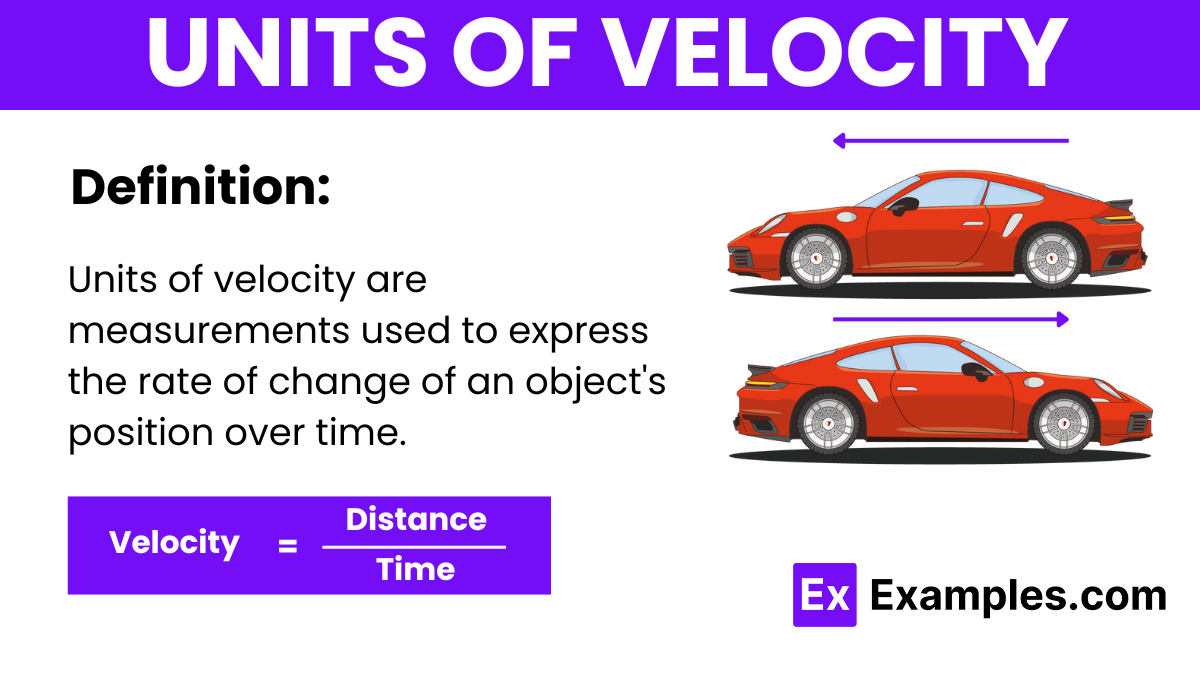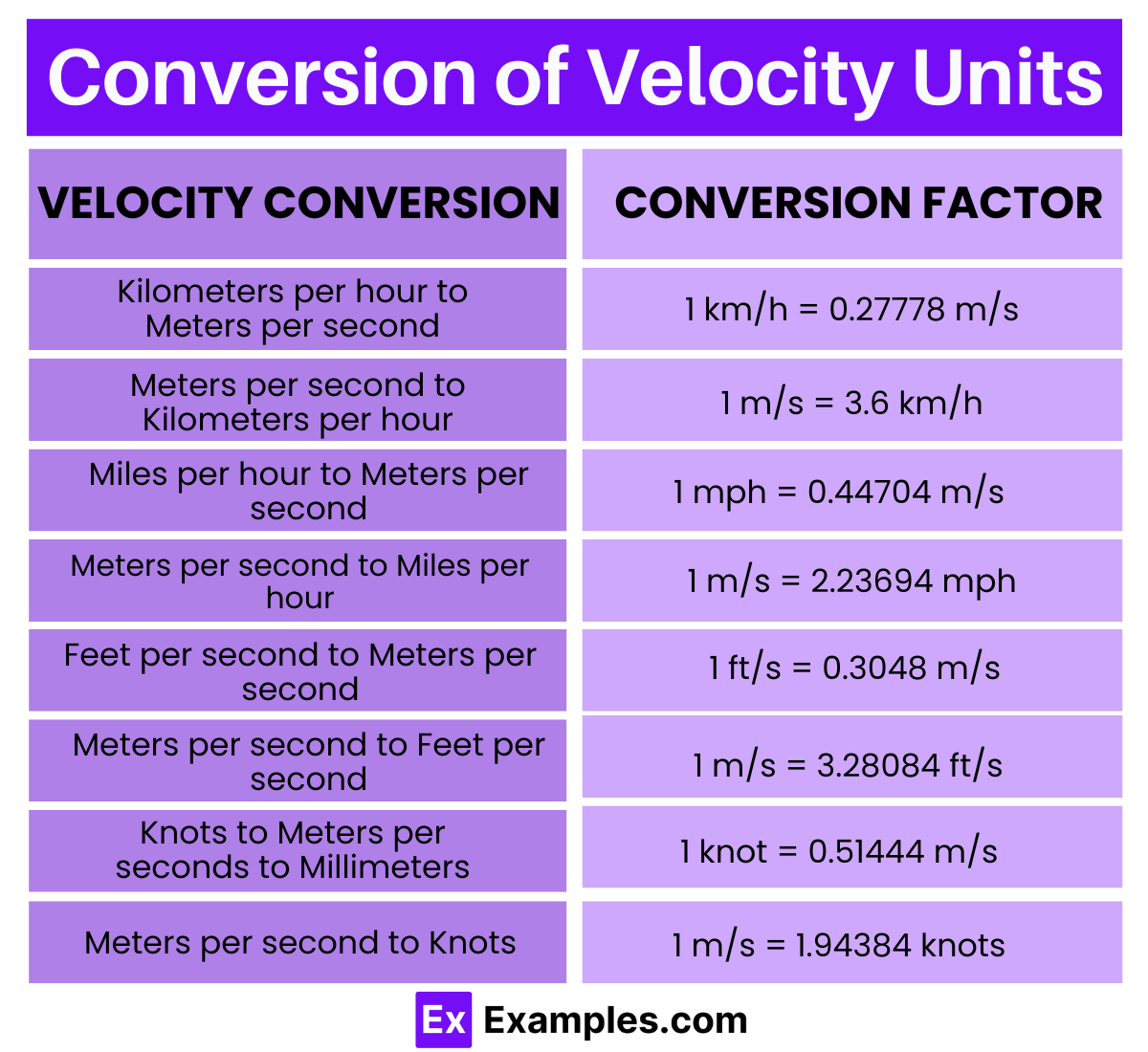Which of the following is the SI unit of velocity?
Meter per second
Kilometer per hour
Miles per hour
Feet per second


The SI (International System of Units) unit of velocity is meters per second (m/s). This unit represents the rate at which an object covers distance in meters for every second of time that elapses. Velocity is a vector quantity, which means it encompasses both the speed (magnitude) of motion and its direction.
Explanation and Use:
Meters per second is commonly used in scientific and engineering contexts to precisely measure how quickly an object is moving in a specific direction.
It is particularly useful in physics to analyze motion, calculate kinetic energy, and solve problems involving forces and acceleration.
In the CGS (Centimeter-Gram-Second) system of units, the unit of velocity is centimeters per second (cm/s). This unit measures how many centimeters an object travels in one second. Like the SI unit meters per second, centimeters per second is a vector quantity, which means it includes both the magnitude and direction of an object’s movement.
Key Points:
Centimeters per second is widely used in scientific contexts that adopt the CGS system, particularly in physics and engineering calculations where smaller scales are involved.
This unit is crucial for precise measurements in experiments and theoretical physics that require the CGS system for unit consistency.
The MKS (Meter-Kilogram-Second) system is a metric system of units that uses the meter, kilogram, and second as base units for length, mass, and time, respectively. In the MKS system, the unit of velocity is meters per second (m/s). This unit measures how many meters an object travels in one second and is a vector quantity, indicating both the speed and direction of motion.
Usage:
Meters per second is the standard scientific unit for velocity in many fields, including physics, engineering, and meteorology.
Kilometers per hour is commonly used in everyday contexts, such as road speeds in many parts of the world.
| Unit of Velocity | Symbol | Conversion to Meters per Second (m/s) | Common Usage |
|---|---|---|---|
| Meters per second | m/s | 1 m/s = 1 m/s | Standard scientific unit worldwide |
| Kilometers per hour | km/h | 1 km/h ≈ 0.27778 m/s | Common in road speeds outside the US |
| Miles per hour | mph | 1 mph ≈ 0.44704 m/s | Road speeds in the US and UK |
| Feet per second | ft/s | 1 ft/s ≈ 0.3048 m/s | Engineering and scientific calculations in the US |
| Knots | knot | 1 knot ≈ 0.51444 m/s | Nautical and aeronautical velocities |
| Mach number (at sea level) | Mach | 1 Mach ≈ 343 m/s (varies with altitude and conditions) | Aeronautics to describe speed of sound |

| Velocity Conversion | Conversion Factor |
|---|---|
| Kilometers per hour to Meters per second | 1 km/h = 0.27778 m/s |
| Meters per second to Kilometers per hour | 1 m/s = 3.6 km/h |
| Miles per hour to Meters per second | 1 mph = 0.44704 m/s |
| Meters per second to Miles per hour | 1 m/s = 2.23694 mph |
| Feet per second to Meters per second | 1 ft/s = 0.3048 m/s |
| Meters per second to Feet per second | 1 m/s = 3.28084 ft/s |
| Knots to Meters per second | 1 knot = 0.51444 m/s |
| Meters per second to Knots | 1 m/s = 1.94384 knots |
One kilometer per hour (km/h) is equivalent to approximately 0.27778 meters per second (m/s). This conversion is commonly used in transportation and sports to transition between speed measurements.
One meter per second (m/s) equals approximately 3.6 kilometers per hour (km/h). This conversion simplifies speed calculations in fields such as physics, engineering, and meteorology.
One mile per hour (mph) is equal to approximately 0.44704 meters per second (m/s). This conversion is often used in automotive and aviation industries for speed measurements.
One meter per second (m/s) is approximately equivalent to 2.23694 miles per hour (mph). This conversion is frequently employed in weather forecasting, vehicle speedometers, and athletics.
One foot per second (ft/s) equals approximately 0.3048 meters per second (m/s). This conversion is utilized in physics, engineering, and fluid mechanics for velocity calculations.
One meter per second (m/s) is approximately equal to 3.28084 feet per second (ft/s). This conversion is essential for various applications, including motion analysis and fluid dynamics.
One knot is equivalent to approximately 0.51444 meters per second (m/s). This conversion is commonly used in maritime and aviation industries for measuring speed over water and air.
One meter per second (m/s) equals approximately 1.94384 knots. This conversion simplifies speed calculations in navigation, sailing, and aviation.
Yes, other common units include kilometers per hour (km/h), miles per hour (mph), and knots (nautical miles per hour). These units are often used in specific contexts like road travel, aviation, and maritime navigation.
Speed is a scalar quantity that refers only to how fast an object is moving. Velocity, on the other hand, is a vector quantity that describes both the speed and the direction of the object’s movement.
Yes, in one-dimensional motion, velocity can be negative, indicating that the object is moving in the opposite direction to the defined positive direction.
In the aerospace industry, knots are commonly used for airspeed, and Mach number is used to express the ratio of the speed of an object to the speed of sound in the surrounding medium.
Text prompt
Add Tone
10 Examples of Public speaking
20 Examples of Gas lighting
Which of the following is the SI unit of velocity?
Meter per second
Kilometer per hour
Miles per hour
Feet per second
What unit is commonly used to express the speed of a car in the United States?
Meter per second
Kilometer per hour
Miles per hour
Feet per second
Convert 72 kilometers per hour to meters per second.
10 m/s
20 m/s
20 m/s
20 m/s
A plane travels at a speed of 500 miles per hour. What is this speed in feet per second?
400 ft/s
400 ft/s
733 ft/s
880 ft/s
Which unit is not typically used to measure velocity?
Meter per second
Kilometer per hour
Newton per second
Feet per second
If an object moves at 15 meters per second, how many kilometers per hour is this?
54 km/h
45 km/h
36 km/h
72 km/h
Convert 120 kilometers per hour to miles per hour.
50 mph
60 mph
60 mph
75 mph
A cyclist travels at 8 meters per second. How many kilometers will the cyclist travel in one hour?
28.8 km
14.4 km
36.0 km
48.0 km
Which of the following is not a unit of velocity?
Meter per second
Kilometer per hour
Miles per hour
Joules per second
Which unit would be used to measure the speed of a ship at sea?
Knots
Miles per hour
Feet per second
Meters per second
Before you leave, take our quick quiz to enhance your learning!

